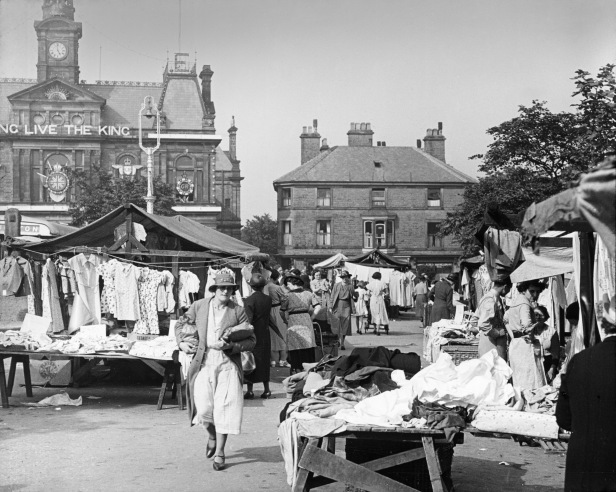Standing on the windswept space in Higher Buxton, you probably don’t need to be told that it’s the highest market place in England. If it is a Tuesday or a Saturday, you may find a few plucky traders braving the elements. Any other day, you will discover an absence of anything resembling a market but the place is still the beating heart of Higher Buxton; fringed with characterful pubs, colourful cafes and independent shops. Just off the market place, at the top of the summit of Terrace Road, you can find a rather excellent museum and art gallery (if we do say so ourselves). Tourists tend to gravitate towards the more well-known landmarks of Lower Buxton at the bottom end and there’s nothing wrong with this strategy; just don’t miss out on the more hip part of town.
So how has this vibrant spot developed? Let’s take a look …

This oil painting by Robert Brunt depicts an early 19th century Buxton market place that is barely recognisable today. There is a patch of bare earth where a dozen people and a hurried hound go about their business. A lone lady appears to be selling something from a barrel on wheels. Nobody seems troubled by what appears to be a giant rocket. In the background, sparse groups of buildings huddle together in the shadow of barren hills. The only familiar feature is the market cross.

A slightly later interpretation in 1849 by Godfrey Sykes adopts an almost identical point of view. The artistic approach is more realistic and the sky is brooding, pregnant with the promise of inclement weather; a feature of Buxton we are more acquainted with. Back then, most of the land was owned by the Duke of Devonshire and Buxton was a fairly remote spa town, reached only by foot, horse or coach. The rider in the painting looks more richly-attired than the other characters in the scene and somehow more erect; a local dignitary whose well-heeled shoes are spared the dirt of the road.

It’s 1875 and this corner of the market place has begun to evolve into what it is today. The Eagle public house still stands although it was known originally as The Eagle and Child. One of the businesses to its right, Hargreaves, has also survived, albeit in a different part of town. There seems to be a few gentlemen in dark suits knocking about, likely the owners of the establishments, keen to get themselves in the photo; a novelty at the time. Most striking, however, is the rather magnificent gas lamp on the left periphery. Not far to the right would have stood the market hall, which burnt down ten years later. You can read about lost Buxton buildings here.

Fast forward a few decades to 1937 and the town hall has replaced the ill-fated indoor market, resplendently proclaiming the ascension of King George IV. The traders must now contend with a stall outside, at the mercy of the clouds, where they have been ever since. Mr Baddley’s photograph was taken on a fine day and the scene looks like some wonderfully chaotic haberdashery. The area is now a car park, perhaps a little mundane in comparison but we can forgive the town planners of previous centuries for failing to foresee the volume of traffic.

J.R. Board took this photo at the other end of the market place in 1925. This shot is notable for the sheer amount of people who have gathered to see the annual dressing of the well. It looks like the whole of Buxton has turned up. Well dressing still takes place every July and gets a lot of attention but not quite on this scale. Nearly one hundred years later, perhaps such traditions have to compete with other activities. At one time, the purpose of the custom was to give thanks to the Duke of Devonshire for the free supply of water but it now has more religious significance. There is evidence to suggest the Roman Empire also revered the water of Buxton and the Celtic people who lived here before their arrival.

Here’s a fun image from the Derbyshire Police collection to finish off the tour. The photograph is focussed on the motorcycle but it also captures the fun fair and the crowds lining the road, waiting for the carnival procession, sometime in the mid-1980s. You may recognise some of the rides in the background. You may even recognise yourself!
Please note that all of the images in this post are protected by copyright. If you wish to use any of them, please email buxton.museum@derbyshire.gov.uk to ask for permission.
To see more local photographs and artwork, why not visit Buxton Museum and Art Gallery in person? You can plan your visit here.


Lovely article Ben! I did once read that there used to be another section of buildings in the center of the market place in front of the eagle aswell?
LikeLike
Thanks, Bob. I haven’t heard about that but you could be right. The Victorians had an underground toilet around there so anything’s possible.
LikeLike
I savour, lead to I discovered exactly what I was having a
look for. You have ended my 4 day long hunt!
God Bless you man. Have a nice day. Bye
LikeLike